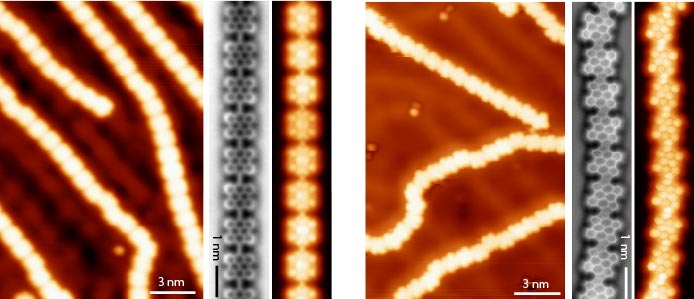Exploiting molecular vibrations to synthesize low-bandgap polymers
 |
|
Two types of bisanthene polymers synthesized on a gold surface with atomic precision. CC-BY Nat. Commun. 11, 4567 (2020). |
📅 05.10.2020
Researchers study a novel strategy to synthesize low bandgap polymers on a gold surface taking advantage of their molecular vibrations. The work combines the chemical synthesis with STM and AFM studies of the electronic properties of bisanthene polymers, whose synthesis is not feasible by conventional methods.
Conjugated polymers are organic macromolecules that are characterized by a backbone chain of alternating double- and single-bonds. Their overlapping p-orbitals create a cloud of delocalised π-electrons, which can result in interesting and useful optical and electronic properties. The design of π-conjugated polymers is highly desirable for their application in a plethora of devices, for example in tailor-made components for nanoelectronics.
Conjugated polymers synthesized by wet chemistry present defects that are incompatible with the requirements of atomic-precise electronics. The topology of the π-electron network is crucial since it determines the ground state electronic structure of such materials. It is therefore interesting to design protocols that allow to produce low-bandgap π-conjugated polymers. On-surface chemistry is a promising procedure that allows the engineering of such macromolecules with control over the synthesis and structural characterization at the atomic scale, by means of scanning probe microscopy.
Researchers from Czech Republic and Spain have joined efforts to design chemically robust and low-bandgap polymers. Their proposed unconventional strategy exploits the relation between π- conjugation and specific vibrational modes, in order to increase the attempt frequency of a chemical reaction, thus introducing the importance of vibrational modes in chemical design on surfaces.
They designed a one-atom-thick polymer on Au(111) based on bisanthene monomers linked by cumulene bridges (Figure, left panel) that exhibit specific vibrational modes. In a second step, upon further annealing, such vibrational modes steer the reaction between adjacent bisanthene moieties, which gives rise to a long pentalene-bridged polymer (Figure, right panel) featuring a low bandgap. The resonance and electronic properties of the products were characterized in detail by scanning tunneling microscopy (STM) and non-contact atomic force microscopy (nc- AFM) supported by density functional theory (DFT) study of the on-surface reactions.
“Our results introduce the relevance of tailoring π-conjugation resonance form to steer vibrational modes on surfaces with the aim of promoting otherwise precluded chemical reaction pathways”, says Prof. David Écija. “The presented study indicates that not only the transition state, but also the internal vibrational modes of the reactant may play an important role in reaction mechanisms”, reveals Prof. Pavel Jelínek. “We envision our results will open pathways to design highly demanded conjugated nanomaterials, while showing strategies to incorporate non-benzenoid moieties in polymeric science”, explains Prof. Nazario Martín.
 This publication is the result of a collaborative research between IMDEA Nanociencia, Complutense University of Madrid, Palacký University Olomouc, Czech Academy of Sciences, and Autonomous University of Madrid, and developed within the frame of the research projects ELECNANO (ERC) and QUIMTRONIC (Comunidad de Madrid). It is partially funded by the Severo Ochoa Programme for Centres of Excellence in R&D awarded to IMDEA Nanociencia.
This publication is the result of a collaborative research between IMDEA Nanociencia, Complutense University of Madrid, Palacký University Olomouc, Czech Academy of Sciences, and Autonomous University of Madrid, and developed within the frame of the research projects ELECNANO (ERC) and QUIMTRONIC (Comunidad de Madrid). It is partially funded by the Severo Ochoa Programme for Centres of Excellence in R&D awarded to IMDEA Nanociencia.
ELECNANO is the project of the ERC Consolidator Grant awarded to David Écija, that aims to design of electrically tunable functional lanthanide nanomaterials.
Reference:
B. de la Torre et al. Tailoring π-conjugation and vibrational modes to steer on-surface synthesis of pentalene-bridged ladder polymers. Nat. Commun. 11, 4567 (2020). DOI: 10.1038/s41467-020-18371-2.
Contact:
Prof. David Écija
This email address is being protected from spambots. You need JavaScript enabled to view it.
Prof. Nazario Martín
This email address is being protected from spambots. You need JavaScript enabled to view it.
Prof. Pavel Jelínek
This email address is being protected from spambots. You need JavaScript enabled to view it.
IMDEA Nanociencia Outreach Office
This email address is being protected from spambots. You need JavaScript enabled to view it.
+34 91 299 87 12
Twitter: @imdea_nano
Facebook: @imdeananociencia
Instagram: @imdeananociencia
Source: IMDEA Nanociencia




